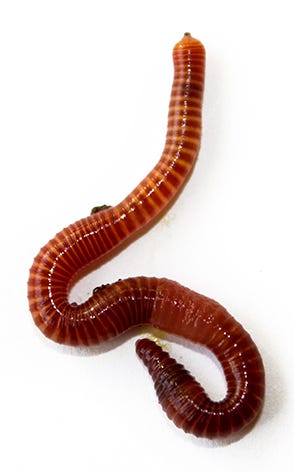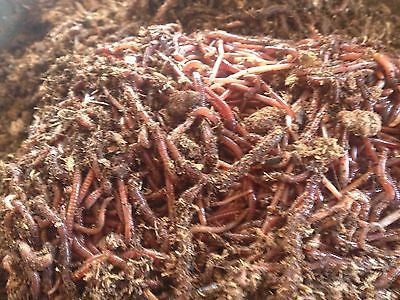Red Wiggler Worms - Perfect for Vermicomposting and Dirt Enrichment
Red Wiggler Worms - Perfect for Vermicomposting and Dirt Enrichment
Blog Article
Red Wiggler Worms Demystified: Unlocking the Keys of Vermiculture for Greener Living and Nutrient-Rich Soil
In the world of sustainable techniques for enriching soil high quality and promoting eco-conscious living, red wiggler worms play an essential yet often overlooked duty. These modest animals have the amazing capacity to transform natural waste right into nutrient-rich castings that serve as a powerful natural plant food. By delving into the world of vermiculture, one can reveal a wide variety of benefits that prolong much beyond conventional composting approaches. Comprehending the details of caring for these worms, maximizing their environment, and using their castings can lead to a greener lifestyle and much healthier soil for plants to prosper.
The Duty of Red Wiggler Worms
Red Wiggler worms play an essential function in composting systems by effectively damaging down organic matter right into nutrient-rich spreadings. These voracious eaters eat a range of natural materials, such as cooking area scraps, yard waste, and paper items. As they feed, the worms' digestive system processes break down the raw material right into a fine, dark, and nutrient-dense product referred to as worm castings or vermicompost.
The castings produced by Red Wiggler worms are highly helpful for dirt health and plant growth. They are abundant in crucial nutrients like phosphorus, nitrogen, and potassium, which are vital for supporting healthy plant development. Furthermore, worm castings consist of helpful germs and enzymes that help improve soil structure, boost water retention, and enhance nutrient uptake by plants.
Benefits of Vermicomposting

It boosts soil structure, improves dirt aeration, and enhances soil dampness retention. Vermicompost also improves the soil with necessary nutrients like potassium, nitrogen, and phosphorus, advertising plant development and general dirt fertility.
Furthermore, vermicomposting supports sustainable gardening methods by supplying a natural and chemical-free alternative to synthetic plant foods. Red Wiggler Worms. This environmentally friendly method not just enhances the soil however likewise helps decrease dependence on harmful chemicals, promoting a greener and a lot more lasting way of gardening
Establishing a Worm Bin
When establishing a worm bin for vermicomposting, correct setup is important to make sure the success of the composting process. The primary step in establishing up a worm container is picking an ideal container. This can be a plastic container or wooden box that offers enough room for the worms to walk around and has appropriate water drainage holes to stop waterlogging. Next off, a bed linens product such as shredded newspaper, cardboard, or coconut coir need to be contributed to the container. This bedding gives a comfortable environment for the worms and aids maintain moisture levels.
After adding the bed linens, present the red wiggler worms to the bin. It is recommended to begin with a handful of worms and slowly increase as they multiply. The worms should then be provided with food scraps such as fruit and veggie peels, coffee premises, and eggshells. It is necessary to stay clear of including meat, dairy products, oily, or salted foods website here to stop bring in pests and producing unpleasant odors.
Regularly keep track of the wetness levels and temperature in the worm container to ensure optimal conditions for the worms. With correct setup and upkeep, the worm container will properly transform natural waste into nutrient-rich compost for your plants and garden.
Harvesting Worm Spreadings
To effectively gather nutrient-rich worm spreadings from your vermicomposting system, an organized harvesting technique is essential. When it comes time to gather the worm castings, there are a few crucial steps to comply with to guarantee an effective process. Quit including fresh food scraps to one side of the worm bin for a pair of weeks before harvesting. This urges the worms to move sideways with fresh bedding and food, making it less complicated to dig the spreadings from the other side.

Troubleshooting Common Issues
Identifying and attending to common difficulties that might develop during the vermicomposting procedure is crucial for maintaining a efficient and healthy and balanced worm bin. Adding excess food scraps can lead to a buildup of dampness and acidity in the worm bin, possibly damaging the worms. An additional problem is unpleasant odors emanating from the worm container.
Furthermore, if the worm population is decreasing or the worms appear unhealthy, it can be because of environmental stressors such as severe temperatures or pH degrees. Keeping track of these factors and making needed adjustments is important for the wellness of the worms. By fixing these typical problems immediately, vermicomposters can ensure a smooth and effective vermicomposting process while keeping a thriving worm populace.

Conclusion
To conclude, red wiggler worms play a critical role in vermiculture by breaking down raw material into nutrient-rich soil. The benefits of vermiculture consist of greener living and boosted soil quality. Establishing a worm bin is vital for successful vermiculture, and gathering worm castings supplies beneficial garden compost for gardening. By comprehending and troubleshooting common issues, people can open the secrets of vermiculture for lasting living and healthier soil.
As they feed, the worms' digestive processes break down the natural matter right into a penalty, dark, and nutrient-dense material known as worm spreadings or vermicompost.
The spreadings created by Red Wiggler worms are highly useful for soil wellness and plant development. Adding excess food scraps can Read Full Report lead to a buildup of dampness and acidity in the worm container, potentially hurting the worms.Additionally, if the worm population is decreasing or the worms show up undesirable, it could be due to environmental stressors such as severe temperatures or pH degrees. Establishing up a worm bin is vital for effective vermiculture, and harvesting worm castings provides important garden compost for gardening.
Report this page